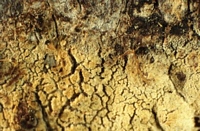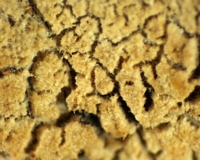|
 Tubulicrinis gracillimus Tubulicrinis gracillimus
SynonymsPeniophora gracillima
Corticium glebulosum
BiostatusPresent in region - Indigenous. Non endemic
Images (click to enlarge)
Caption: Tubulicrinis gracillimus, BCP 3066
Owner: B.C. Paulus | 
Caption: Tubulicrinis gracillimus, BCP 3066
Owner: B.C. Paulus |
Article: Cunningham, G.H. (1963). The Thelephoraceae of Australia and New Zealand. New Zealand Department of Scientific and Industrial Research, Bulletin 145: 359 p. Wellington:.
Description: Hymenophore annual, membranous, adherent, effused,
forming linear areas to 12 x 3 cm; hymenial surface cream, pruinose, deeply
areolately creviced; margin thinning out, arachnoid, white, adherent. Context
white, 80-150 µm thick, basal layer of a few repent hyphae, intermediate layer
of densely arranged mainly erect hyphae among which, at the base, are few or
many thick-walled hyphae; generative hyphae 2.5-4 µmdiameter, walls 0.5 µm
thick, naked, with clamp connections. Cystidia arising from the basal layer and
projecting to 65 µm, naked, cylindrical, 65-144 x 8-12 µm, lumena capillary,
apices thin-walled and rounded. Hymenial layer to 25 µm, deep, a close palisade
of basidia, paraphyses, and cystidia. Basidia subclavate, 12-16 x 4-5 µm,
bearing 4 spores; sterigmata erect, slender, to 8 µm long. Paraphyses
subclavate, 6-10 x 3.5-4 µm. Spores cylindrical or allantoid, with rounded ends,
6-8 x 1.5-2 µm, walls smooth, hyaline, 0.1 µm thick.
Habitat: HABITAT: Effused on bark or
decorticated wood of dead branches.
Distribution: DISTRIBUTION: North America, Europe, Great Britain, South Africa,
Australia, New Zealand.
Notes: Cystidia are cylindrical, with walls so thickened, save at apices, that
lumena are capillary. Apices remain thin-walled, so that cystidia simulate
inverted miniature thermometers. Cystidia arise in the context as deeply
staining, thin-walled organs, resembling gloeocystidia. Shortly their walls
become thickened from within until lumena are almost obliterated. Spores are
similar in shape to those of T. subalutacea, but smaller. The
intermediate tissue consists mainly of erect sparsely branched hyphae with, near
the base, intertwined convoluted thick-walled hyphae of the same diameter. The
latter are extensions of basal roots of the cystidia, may be abundant or scanty,
and sometimes occupy one-third of the base of the context. As the name
Peniophora glebulosa (Fr. ex Bres.) Sacc. & Syd. cannot be employed
for the species, being a nomen confusum, Rogers & Jackson applied
to the cystidiate species of the complex, with a validating description, the
herbarium name used by Ellis & Everhart.
|